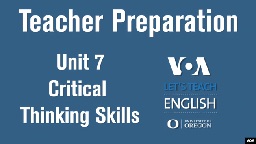 Video Transcript Video Transcript
Narrator: The focus of this lesson is teaching analytical thinking skills.
The teacher
leads the class through an exercise developed by Stella Ting-Toomey
called “Describe, Interpret, Evaluate” or see, think, feel. |
|
|
Teacher: Today we will try a new way to look at things we don't know about.
First,
we will look at a picture and say only what we see.
(The teacher points to the poster with the “Describe, Interpret, Evaluate”
questions. The first question is “What do you see?”.)
Teacher: Let’s use this photo as an example.
(A photo of a woman with insects crawling on her appears on the screen.)
Students: Ew!
Teacher: Remember, we are not saying how we feel yet . . . only what we see.
(Maryam raises her hand and the teacher points to her.)
Maryam: I see a big, long . . . what's that thing?
(Maryam points to the stick bug)
Mimi: It’s an insect?
Teacher: Right. What else do you see?
(Julia raises her hand.)
Julia: I see a woman.
Teacher: Okay. Anyone else?
(Jaime raises her hand.)
Jamie: Her eyes are closed.
Teacher: Okay.
Emma: There is another big insect on her arm.
(The teacher points to the cockroach.)
Teacher: Good. Next, we will guess why it is happening.
(The teacher points to the poster with the “Describe, Interpret, Evaluate”
questions. The second question is “Why is it happening?”.)
Teacher: Can anyone guess?
(Maryam raises her hand and the teacher points to her.)
Teacher: Maryam?
Maryam: Maybe she likes to play with insects.
Julia: Maybe the insects are not real.
Teacher: Good guesses. Finally, we can say how we feel.
(The teacher points to the poster with the “Describe, Interpret, Evaluate”
questions. The third question is “How do you feel?”.)
Teacher: Yes?
Emma: I’m happy because the insects are not on me!
(The teacher laughs.)
Teacher: Okay.
Jamie: I think she is beautiful and the insects are ugly.
(The photo of a woman with insects crawling on her appears on the
screen.)
Julia: I want to know what is really happening.
Teacher: Well, she is a scientist. Some of the insects are real and some are
not.
(A photo of a man and woman sliding in the mud appears on the screen.)
Teacher: Now, look at this picture and talk to your classmates.
Teacher: Remember, first, only tell them what you see.
(The teacher points to the poster with the “Describe, Interpret, Evaluate”
questions. The first question is “What do you see?”.)
(A banner with the word “describe” appears on the screen.)
Jamie: What do you see?
Maryam: I see a woman and a man. They are on the dirt.
(A banner with the word “interpret” appears on the screen.)
Julia: Maybe they are playing baseball.
Teacher: Okay, let’s stop here. Who wants to tell us their guesses? Yes.
Jamie: I think they are playing a game. Maybe they are having fun.
Teacher: Okay. Yes.
Mimi: I think they are racing.
(A banner with the word “evaluate” appears on the screen.)
Mimi: I don’t like running. It’s too hot.
Maryam: Oh! Is that your opinion?
Mimi: I guess so, yes.
Teacher: Was it hard to guess and not give your opinion?
(Students nod their heads affirmatively.)
Julia: Yeah.
Teacher: Okay. Now, I would like you to remember the first time you met
someone
from another culture. Who has an example?
(Maryam raises her hand and the teacher points to her.)
Maryam: I remember the first time I met someone from the United States.
Teacher: What did you think at first?
Maryam: I thought she was very strange.
Teacher: Okay, now think about what we did today with the first picture.
(The teacher points to the picture of the woman with insects crawling on
her.)
Teacher: How was that the same?
(Julia raises her hand and the teacher points to her.)
Teacher: Yes.
Julia: Well, at first, I thought the woman with the insects was strange.
Teacher: Okay.
Maryam: Yes, but then we talked only about the things we saw.
Teacher: Yes.
Emma: And then we talked about maybe why she looked that way.
(The teacher points to the poster with the “Describe, Interpret, Evaluate”
questions. The second question is “Why is it happening?”.)
Teacher: Good.
Mimi: We waited to tell our feelings after all that.
(The poster with the “Describe, Interpret, Evaluate” questions appears on
the screen. The third question is “How do you feel?”.)
Teacher: Yeah! You see. So, we can do the same thing when we meet people
from
a different culture.
(Jaime points to the poster. Only the eyes for the question “What do you
see?” appear on screen.)
Jamie: Yes, we can stop and only look.
(The screen shows the “Why is it happening?” question on the poster.)
Mimi: Then we can think about why.
Teacher: Finally, what did we do?
(Maryam raises her hand and the teacher points to her.)
Maryam: We gave our opinion: how we feel.
(The screen shows the “How do you feel?” question on the poster.)
Teacher: Right. Do you think "how you feel" was different after you first
asked
“what” and “why”?
Julia: Yeah, like in the baseball picture.
(The photo of a man and woman sliding in the mud appears on the
screen.)
Julia: At first I thought, “Ew.” Now I think, “It looks fun!”
(The teacher points to Maryam.)
Teacher: Yes.
Maryam: I think we need to try to understand first. Then, we can say how we
feel
about it.
Narrator: The students move through the process of carefully examining an
event
before they form an opinion about it. The teacher compares this process
to intercultural contact, and encourages thoughtful reflection on cultural
differences. Next time, join us for Unit 8. We will teach visual literacy. |
|